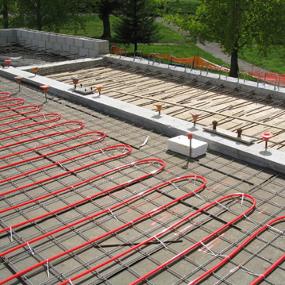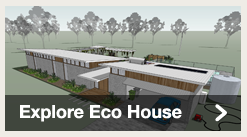Build it Back Greenbushfires
Hydronic Heating
 Solar
hydronic heating warms your home by taking advantage of an
environmentally friendly energy source-the sun. Hydronic heating
systems are typically gas-fired and have been used in Europe for
almost a century. Solar hydronic heating systems that use evacuated
tube solar collectors as the primary method of heating the water
needed for the hydronic circuit are now available on the
market.
Solar
hydronic heating warms your home by taking advantage of an
environmentally friendly energy source-the sun. Hydronic heating
systems are typically gas-fired and have been used in Europe for
almost a century. Solar hydronic heating systems that use evacuated
tube solar collectors as the primary method of heating the water
needed for the hydronic circuit are now available on the
market.
Solar collectors capture energy from the sun and heat the water in a storage tank to the required temperature via a coil in the top of the tank. If the solar system does not heat the water in the pipes sufficiently, a backup heat source comes on and boosts the temperature. A pump circulates the hot water through pipes around the hydronic circuit, and the heat is transferred into the room through wall mounted panel radiators or through piping laid in a concrete slab floor during house construction. A separate heat exchange coil in the tank can provide domestic hot water for household use.
The backup burner can be run off natural gas, solid fuel, LPG, or even an electric heat pump. If you live in an urban area the most economical and environmentally friendly fuel for the backup is natural gas. Solid fuel can be labour intensive and LPG can be up to two and a half times more expensive than natural gas and will significantly increase the running costs of the system.
Panel radiators are most commonly made of pressed steel and can be installed in existing homes or during the building process. Each panel can be controlled independently, which gives you the benefit of being able to shut off heating in rooms that are not being used.
In-slab piping or 'foil coils'-made from polyethylene-are generally installed during the building process, but a concrete slab can sometimes be introduced to an existing home during renovations. When considering in-slab piping for your home talk to a concreter who is familiar with your area to ensure that your slab is not likely to shift or crack. The piping can tolerate some kinks and movement, but in-slab piping will not be suitable for all land areas. The piping is usually laid out in a minimum of three zones, which gives you the benefit of controlling heating to only the rooms which are being used. Once heated, the concrete slab floor converts into a radiant heat bank that releases heat evenly throughout an area.
In-slab floors can be tiled or the slab can be finished as a polished concrete floor. Carpet is generally unsuitable, due to the carpet underlay acting as an insulator and preventing the heat being released, but floor rugs can be an option. Timber floors can be laid over in-slab piping. However, the thickness of the wood can impact on heat transference and may also affect the warranty on the timber as the wood may shrink and buckle if it is not already kiln dried.
Solar hydronic heating with evacuated tube solar collectors is ideally suited to the Victorian climate. The response time of the heating will vary depending on your ceiling height and the level of insulation in your home, but in a house with a 5-star rating you will feel warm in about 20 minutes. With in-slab piping, areas are warmed evenly from the floor upwards which means the entire air mass is not being heated, resulting in reduced heat loss. Once your home is warm it is only a matter of maintaining the temperature, particularly if the rooms are well insulated.
Costs will vary greatly depending on the installation requirements, control choices, the size of your home and the backup burner fuel. Upfront installation costs tend to be much more than traditional gas duct heating but you will save on running costs and create a comfortable, more sustainable home while reducing your household carbon emissions.
Provided the system is serviced and maintained according to the manufacturer's instructions, the life span of the system could quite reasonably reach 20 to 30 years. The pumps and valves may need replacing throughout the system's life but the replacement costs will be relatively small. The federal and Victorian government offer a rebate for installing solar hot water systems.
Solar hydronic heating can be a comfortable and reliable form of heating which allows for temperature control and zoning to heat only the necessary areas. The system is silent, so there are no draughts or noise from fans. This makes it ideal for allergy sufferers and asthmatics as there is minimal air movement or dust circulated throughout the house.
Solar hydronic heating also has the benefit of minimising carbon emissions by utilising energy captured from the sun. The running costs and greenhouse gas emissions of a hydronic system tends to be lower compared to conventional heating methods such as central heating, but again this will vary depending on the fuel source of your backup burner.
It is important to remember that hydronic heating systems need to be installed by an experienced professional and the addition of a solar component increases the complexity of the system.
Suppliers
Hunt Heating - www.huntheat.com.au
Ph. 1300 001 800
Solar Hydronics - www.solarhydronics.com.au
Ph. 0408 419 703
- More Info
- > Sanctuary magazine
Listed suppliers are a guide and are not endorsed by Green Cross Australia or the Alternative Technology Association.




